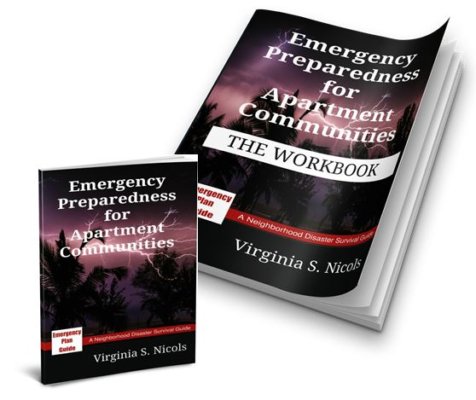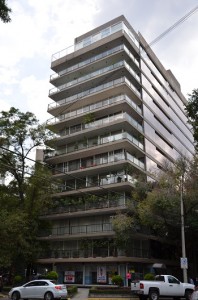Apartment Safety and Security

Why, some of my best friends live in apartments (and condos)!
So much of what we read about preparedness and survival assumes a rural or at least a single-family-home setting, where there is room for a survival garden, water barrels, storage shelves in the basement, etc. There may even be nearby woods where you can practice building shelters, cooking over a campfire, etc.
But what about the 37% of us who live in rental properties, mostly in multi-family buildings? What about our safety and security? We have no room for many of the preparedness activities mentioned above. No place to practice outdoor survival skills. And we can’t just run outside if a fire threatens or we smell a gas leak.
And what role does the property owner play in taking care of safety and security items? Time to find out!
Let’s make sure renters are as prepared for emergencies as anyone else! Starting with . . .
Easily overlooked apartment safety and security recommendations.
Is your apartment secure?
Door locks. Whether you’re moving into a new unit, or have been there for years, take a look at the condition of your locks. Today, reasonable security for an apartment includes a deadbolt and a peephole. In fact, a peephole may even be required by your local building code! Find out before you make any assumptions, of course. And be sure to ask the landlord for help or at least permission to make any changes. You may be able to do these installations yourself, or you may have to pay to get them done. Read below for some ways to save money.
Oh, and while you’re talking with management, be sure to find out the property policy for management or maintenance to enter your apartment.
Balcony security. Don’t forget the locks on your balcony windows and doors, even if you are on the second level. Sliding glass doors are particularly vulnerable. Consider a security bar, or at the very least, a rod cut to the exact length of the sliding door’s track. Here’s an example of an adjustable bar that also locks to keep children from lifting it out.
Security system. If neighbors and/or the police records show danger of unwanted activity in your neighborhood, consider installing a security system. For a more detailed discussion of options, check this Advisory. For your apartment, there are many battery-operated systems that won’t damage the walls, and that you can then take with you when you leave.
Here’s a sample of a simple, battery-operated security system that could be mounted outside or in your apartment for additional safety and security. Click the image for price and full details. (The more options you want — lights, camera, audio, etc. — the more expensive the system, of course. This model is a good start for comparison shopping.)

Are you prepared for fire?
Does your apartment have a sprinkler system? Starting in 2003, all apartment buildings were required to have sprinklers (but smaller and older buildings may have been grandfathered in). If you are moving to a new apartment, check closely. If it doesn’t have sprinklers, you may want to reconsider. (You may recall the story of how Trump Tower only has sprinklers on the lower floors. A fire there in 2018 killed a resident and injured six firefighters.)
Smoke alarms and carbon monoxide detectors? Do they work? Don’t take a chance. Test, require they be replaced or replace them yourself. Depending on the type of sensing equipment you choose, you can get alarms for around $15-$20. (Here’s a link to our alarms reviews.) According to The U.S. Fire Administration, more than one-third (38 percent) of home fire deaths result from fires in which no smoke alarms are present!
Do you have a home fire extinguisher? More than one? Are the extinguishers located where kids or someone in a wheelchair can reach them? Does everyone in the home know how to operate the extinguisher?
Can you get out of your apartment safely?
Getting out of a large complex is a lot different than fleeing a burning home! So, lots to think about.
Just as you want to know that your doors and windows can be locked, you want to test to be sure they all OPEN in case of emergency.
The standard “Family Evacuation Plan” calls for you to identify two ways to exit every room. Obviously, in a rental apartment, that may be tough, because the second exit is probably though a window. Can you actually get out your window? Can you get down to the ground safely? Does your family plan have a place for you to reassemble after having evacuated?
If your apartment is no higher than 4 stories, consider an escape ladder. Escape ladders are available in 2 to 6 story lengths, but the longer ones become quite a bit more expensive, and of course are more demanding in terms of required strength and agility.
Since in an emergency you could get trapped in an elevator, do you have more than one stairwell as an option for your family? Do all family members know where other stairwells are located? Are these stairwells well marked? If a family member is unable to get down stairs, do you have a plan for carrying that person down? Do you have the equipment that would make carrying possible?
Evacuation chairs and evacuation sleds may be the only way to get someone who is ill or unable to walk down stairs safely in an emergency. Find out about costs and capacity (different sizes for different sized people), note whether equipment takes two people or just one person to operate. Here is a place to start your research. And below see a 4 min. video that will give you a good idea of just how an emergency sled works.
Do you have renter’s insurance?
Worth it. Check with neighbors to see what they have. The discussion alone will add to the safety and security of your apartment! Bring up the topic at a community meeting. Bring up the idea in the next paragraph at a community meeting, too!
Does your community have a community emergency response plan?
Knowing your neighbors is the best defense. They will be the best source of help in an emergency!
Put in the effort to create a community emergency response group and a plan. Engage management’s support and assistance – they have everything to gain by keeping tenants safer, too. Together with management, learn more about your buildings, security, utility service, maintenance, etc. Agree on emergency procedures – who will be responsible for what.
Added benefit of having a group for apartment safety and security
Working together, you will have more power to negotiate with the property owner. And you may be able to save money by buying locks or security lights in bulk. You may also be able to arrange with a handyman or contractor to install them for everyone in the group. Best of all, you could provide a job if that handyman or handywoman is one of your own neighbors!
We’ve written a book to get you started on putting that neighborhood group and plan together.

“The more we all know, the safer we all will be!”
Thanks for taking action on this.
Virginia
Your Emergency Plan Guide team

 But what about renters?
But what about renters?